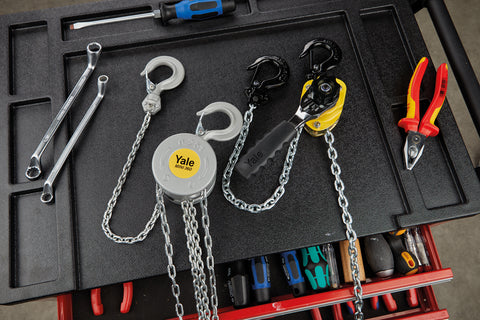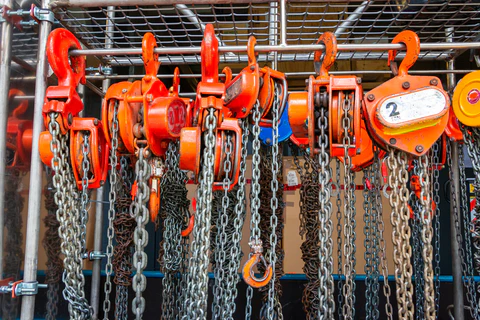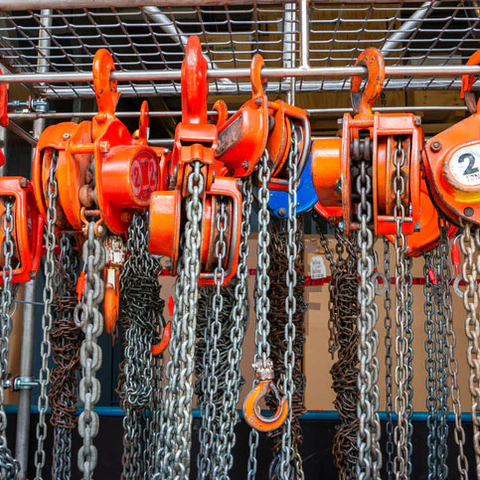Chain blocks are essential tools in many industries, offering a reliable and efficient way to lift and move heavy loads. Whether you're working in construction, manufacturing, or simply tackling a DIY project at home, understanding the fundamentals of chain blocks is key to ensuring safe and effective lifting operations.

**Understanding the basics of chain blocks**
**What is a chain block?**
A chain block, also known as a chain hoist, is a mechanical device designed to lift heavy objects by applying force through a chain. It typically includes a chain, pulleys, and other components that work together to provide smooth and controlled lifting.
**Key components of a chain block**
Chain blocks consist of several important parts, including hooks, load chains, gears, and braking systems. Hooks serve as secure attachment points for lifting objects, while load chains are made from high-strength steel to support heavy weights. Gears help transfer force, making it easier to lift large loads, and braking mechanisms prevent accidental drops, enhancing safety during operation.
Each component plays a vital role in ensuring both the efficiency and safety of the lifting process. The gears multiply the input force, allowing users to handle heavy items with less effort, while the braking system ensures that the load remains stable, even if the operator lets go.
**Different types of chain blocks**
**Manual chain blocks**
Manual chain blocks are the most commonly used type and are operated by hand. They are cost-effective, easy to use, and ideal for light to medium-duty lifting tasks. These blocks are widely used in construction, workshops, and maintenance settings.
One of the main advantages of manual chain blocks is their simplicity and portability. Since they don’t require any external power source, they are perfect for locations where electricity or hydraulic power is unavailable. This makes them especially useful on remote job sites or outdoor projects.

**Electric chain blocks**
Electric chain blocks are powered by electricity and are better suited for heavier lifting tasks. Equipped with electric motors, they offer consistent and controlled lifting, making them ideal for industrial environments like factories, warehouses, and construction sites.
Electric models are particularly beneficial when frequent lifting is required. They reduce physical strain on operators and provide smoother, more precise movement, which is especially important when handling delicate or high-value items.
**How chain blocks work**
**The mechanics of lifting**
When a chain block is in use, the operator pulls the chain, causing it to wrap around the gears and lift the load. As the gears rotate, the chain moves through the pulleys, creating a mechanical advantage that allows heavy objects to be lifted with less effort.
Chain blocks come in various sizes and capacities, each designed to meet specific lifting needs. The durability of the gears and the precision of the pulley system are crucial to the performance of the device. High-quality materials such as steel are often used to ensure long-lasting reliability.
**Safety mechanisms in chain blocks**
Chain blocks are equipped with multiple safety features to protect both the operator and the load. Overload protection prevents the device from being used beyond its rated capacity, while automatic braking systems engage when the lifting stops, preventing accidental drops.
Many models also include a safety latch on the hook to keep the load secure during lifting. Regular inspections and maintenance are essential to ensure these safety features remain functional and the chain block continues to operate safely over time.

**Selecting the right chain block**
**Determining your lifting needs**
Before choosing a chain block, it’s important to assess your specific lifting requirements. Consider the weight of the load and the height you need to lift. Selecting a model with the appropriate lifting capacity and height will ensure safe and efficient operations.
It’s also wise to choose a chain block with a slightly higher capacity than your current needs. This provides flexibility for future projects and avoids the need for frequent upgrades.
**Evaluating chain block quality and safety features**
When purchasing a chain block, always prioritize quality and safety. Look for products that meet international safety standards and have been thoroughly tested. Features like load limiters, corrosion resistance, and ease of maintenance can significantly impact the longevity and reliability of the device.
Checking for certifications from reputable organizations can also give you confidence in the product's quality and safety. These certifications confirm that the chain block has been manufactured to meet strict industry criteria.
By gaining a solid understanding of chain blocks—how they work, their different types, and how to choose the right one—you can make informed decisions that enhance both safety and productivity. Always remember that regular maintenance and proper usage are essential for keeping your chain block in top condition and ensuring it performs reliably for years to come.
tesla ccs adapter,tesla to j1772 adapter,j1772 charger,chademo ccs adapter
Xuchang Shuoniu New Energy Technology Co., Ltd. , https://www.shoniu.com